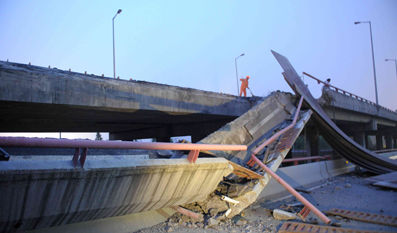Terminally ill 14-year-old, healthy 74-year-old
The Third Bridge of the Qianjiang River was opened for service on Jan. 28, 1997. The main part of the bridge is 1,280 meters long, with approach bridges on both sides adding another 4,420 meters. It links Hangzhou's city center with Xiaoshan International Airport.
Although the construction was evaluated as "high quality" by related authorities, quality problems and criticism from the public have plagued the bridge since the very beginning.
The first thing noticed by industry insiders was that the bridge did not pass quality inspection until June 1998, one year and five months after it had opened for service.
"Qianjiang Third Bridge did not pass the first inspection due to some problems," said Prof. Xu Jun, an engineering expert at Tongji University, who is also an engineer in the re-construction of the bridge. The bridge underwent a series of repairs the following year after it opened for service.
After this month's cave-in, investigators said an overloaded truck was the cause. However, according to the original blueprint, the bridge was designed to handle heavy vehicles weighing more than 120 tons.
In 2005, less than 10 years after its establishment, the bridge was considered terminally ill, with foundation subsidence and cracks and gaps requiring an overhaul. No more overweight vehicles were allowed.
As the old Chinese saying goes, "comparisons are odious." Qianjiang No.2 Bridge, the older model that opened for service in 1992, is under a much larger traffic load than the third one, yet has never restricted any truck to pass.
Nevertheless, the real deal is the Qianjiang Bridge, designed by the renowned Chinese structural engineer Mao Yisheng (1896 - 1989) and built in 1937. The 74-year-old bridge, which was blown up twice during the Sino-Japanese War and the Chinese Civil War, has not been through even one overhaul.
Mao designed the bridge for a service life of 50 years. Now, 24 years after its design limit, the bridge is still functional and solid.
"Mao's bridge is not a bridge of high-end engineering techniques, but a bridge of clean conscience," one web user with the screen name dongguleqiao commented Monday.
The world’s longest ocean bridge, spanning 23 miles, opened in Qingdao, East China's Shandong Province, last month. Web users soon complained about the rushed construction of the bridge after pictures of easily loosened bolts and incomplete safety rails along the bridge were posted online. Last year a bridge in Henan province collapsed, killing 37 people.
The frequency of bridge collapses in China has led to an attitude of cynicism among some sections of the public. “If the bridges didn’t collapse, how else could we rebuild them and boost our GDP?” wrote one commentator on an Internet forum.


















